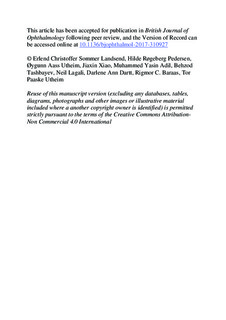| dc.contributor.author | Adil, Muhammed Yasin | |
| dc.contributor.author | Xiao, J | |
| dc.contributor.author | Olaffson, J.S. | |
| dc.contributor.author | Chen, Xiangjun | |
| dc.contributor.author | Lagali, Neil | |
| dc.contributor.author | Ræder, Sten | |
| dc.contributor.author | Utheim, Øygunn Aass | |
| dc.contributor.author | Dartt, Darlene A. | |
| dc.contributor.author | Utheim, Tor Paaske | |
| dc.date.accessioned | 2019-03-08T12:06:33Z | |
| dc.date.available | 2019-03-08T12:06:33Z | |
| dc.date.created | 2019-01-30T11:24:30Z | |
| dc.date.issued | 2018 | |
| dc.identifier.citation | American Journal of Ophthalmology. 2018, 200, 16-25. | nb_NO |
| dc.identifier.issn | 0002-9394 | |
| dc.identifier.uri | http://hdl.handle.net/11250/2589363 | |
| dc.description | Reuse of this manuscript version (excluding any databases, tables, diagrams, photographs and other images or illustrative material included where a another copyright owner is identified) is permitted strictly pursuant to the terms of the Creative Commons Attribution-Non Commercial 4.0 International | nb_NO |
| dc.description.abstract | Purpose To investigate the relationship between meibomian gland (MG) morphology and clinical dry eye tests in patients with meibomian gland dysfunction (MGD). Design Cross-sectional study. Subjects Total 538 MGD patients and 21 healthy controls. Methods MG loss on meibography images of upper (UL) and lower lids (LL) was graded on a scale of 0 (lowest degree of MG loss) to 3. MG length, thickness, and interglandular space in the UL were measured. Clinical tests included meibum expression and quality, tear film break-up time, ocular staining, osmolarity, Schirmer I, blink interval timing, and Ocular Surface Disease Index (OSDI) questionnaire. Results Mean UL and LL meibogrades were significantly higher in MGD patients compared to controls (P < .001 for UL and LL). The sensitivity and specificity of the meibograde as a diagnostic parameter for MGD was 96.7% and 85%, respectively. Schirmer I was significantly increased in MGD patients with meibograde 1 compared to patients with meibograde 0, 2, and 3 in the UL (P < .05). MG thickness increased with higher meibograde (P < .001). MG morphology correlated significantly but weakly with several clinical parameters (P < .05). OSDI did not correlate with any MG morphologic parameter. Conclusions Grading of MG loss using meibograde effectively diagnoses MGD. Compensatory mechanisms such as increased aqueous tear production and dilation of MGs make early detection of MGD difficult by standard clinical measures of dry eye, whereas morphologic analysis of MGs reveals an early stage of MGD, and therefore represents a complementary clinical parameter with diagnostic potential. | nb_NO |
| dc.language.iso | eng | nb_NO |
| dc.rights | Attribution-NonCommercial-NoDerivatives 4.0 Internasjonal | * |
| dc.rights.uri | http://creativecommons.org/licenses/by-nc-nd/4.0/deed.no | * |
| dc.title | Meibomian Gland Morphology is a Sensitive Early Indicator of Meibomian Gland Dysfunction | nb_NO |
| dc.type | Journal article | nb_NO |
| dc.type | Peer reviewed | nb_NO |
| dc.description.version | acceptedVersion | nb_NO |
| dc.rights.holder | © Erlend Christoffer Sommer Landsend, Hilde Røgeberg Pedersen, Øygunn Aass Utheim, Jiaxin Xiao, Muhammed Yasin Adil, Behzod Tashbayev, Neil Lagali, Darlene Ann Dartt, Rigmor C. Baraas, Tor Paaske Utheim | nb_NO |
| dc.source.pagenumber | 16-25 | nb_NO |
| dc.source.volume | 200 | nb_NO |
| dc.source.journal | American Journal of Ophthalmology | nb_NO |
| dc.identifier.doi | 10.1016/j.ajo.2018.12.006 | |
| dc.identifier.cristin | 1668522 | |
| cristin.unitcode | 222,56,2,0 | |
| cristin.unitname | Institutt for optometri, radiografi og lysdesign | |
| cristin.ispublished | true | |
| cristin.fulltext | postprint | |
| cristin.qualitycode | 1 | |

